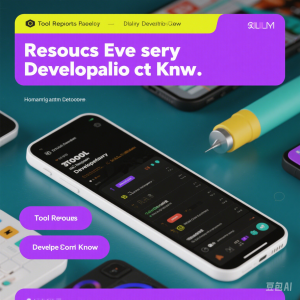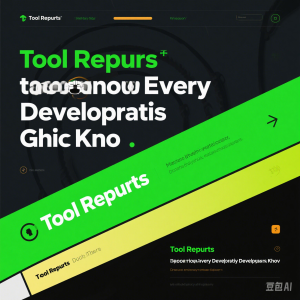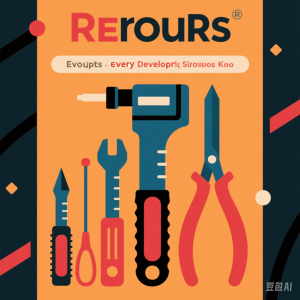Powerful Tool Resources Every Developer Should Explore

In the fast – paced realm of software development, having access to the right tool resources can significantly enhance a developer’s efficiency and the quality of their work. This article delves into some of the powerful tool resources that every developer should consider exploring.
Advanced Code – Writing Assistants for Enhanced Productivity
- Tabnine
Tabnine is an AI – powered code – completion tool that goes beyond basic autocompletion. It analyzes the context of the code being written and provides intelligent code suggestions. For example, when writing a Python function to process a list of numbers, Tabnine can suggest the appropriate built – in functions or algorithms based on the task at hand. It supports multiple programming languages such as Python, JavaScript, Java, and C++. Tabnine can be integrated with popular IDEs like Visual Studio Code, IntelliJ IDEA, and Eclipse. By using Tabnine, developers can save time on writing boilerplate code and focus more on the core logic of their applications.
- Kite
Kite is another intelligent code – writing assistant. It offers real – time code suggestions, API documentation lookup, and even code refactoring assistance. In a JavaScript project, for instance, Kite can not only suggest the correct syntax for a particular JavaScript API but also provide examples of how it has been used in real – world scenarios. It has a unique feature of showing relevant code snippets from open – source projects, which can be a great source of inspiration for developers. Kite can be installed as an extension in major code editors, making it easily accessible during the coding process.
Agile – Oriented Project Management Tools
- Asana
Asana is a popular project management tool that is well – suited for agile development. It allows teams to organize tasks, assign them to team members, set deadlines, and track progress. In an agile software development project, Asana can be used to manage sprints. For example, each user story or task can be represented as a task in Asana, and the team can move these tasks through different stages such as “To – Do”, “In Progress”, and “Done” as the sprint progresses. Asana also provides integrations with other tools like GitHub and Slack, enabling seamless communication and collaboration within the team.
Monday.com offers a highly customizable project management platform. It uses a visual interface with boards, columns, and cards to represent projects, tasks, and their status. In a development team, Monday.com can be customized to fit the specific workflow of the team. For example, the columns can be customized to represent different phases of the development process, such as “Planning”, “Coding”, “Testing”, and “Deployment”. Each card can contain detailed information about a task, including attachments, comments, and due dates. Monday.com also has a mobile app, allowing team members to stay updated and manage tasks on – the – go.
Automated Testing Frameworks for Reliable Code
- Cypress
Cypress is a front – end testing framework that simplifies the process of writing and running end – to – end tests for web applications. It has a simple and intuitive API, making it easy for developers to write tests in JavaScript. For example, a developer can use Cypress to test the functionality of a web page, such as clicking buttons, filling forms, and verifying the results. Cypress runs tests in real – time, providing instant feedback. It also has features like automatic waiting for elements to load, which reduces the need for manual handling of asynchronous operations. Cypress can be integrated with continuous integration (CI) systems, ensuring that the front – end code is thoroughly tested with each code change.
- Pytest
Pytest is a popular testing framework for Python. It is known for its simplicity and flexibility. Pytest allows developers to write unit tests, integration tests, and even end – to – end tests. For example, in a Python data – processing project, a developer can use Pytest to write unit tests for functions that perform data cleaning and transformation. Pytest has a rich ecosystem of plugins, which can be used to extend its functionality. For instance, the “pytest – cov” plugin can be used to measure code coverage, ensuring that a sufficient amount of the codebase is being tested. Pytest can also be easily integrated into the development workflow, such as through a makefile or a CI/CD pipeline.
Cloud – Native Development Platforms
- Google Cloud Platform (GCP) with Cloud Run
Google Cloud Platform, especially when combined with Cloud Run, offers a powerful cloud – native development environment. Cloud Run allows developers to run containerized applications without having to manage servers. For example, a developer can containerize a Python web application using Docker and then deploy it to Cloud Run. Cloud Run automatically scales the application based on the incoming traffic. GCP also provides a wide range of services such as Google Cloud Storage for data storage, Google Cloud SQL for databases, and Google Cloud Functions for serverless computing. These services can be easily integrated with the application, enabling the development of scalable and reliable cloud – native applications.
- Amazon Web Services (AWS) Elastic Beanstalk
AWS Elastic Beanstalk is a cloud – native platform that simplifies the deployment and management of applications. It supports multiple programming languages, including Java, Python, Node.js, and Ruby. For example, a developer can upload a pre – built application code to Elastic Beanstalk, and the platform will handle the deployment, scaling, and monitoring of the application. Elastic Beanstalk also provides easy – to – use wizards and tools for configuring the application environment. It integrates well with other AWS services like Amazon S3, Amazon RDS, and Amazon CloudWatch, allowing developers to build comprehensive cloud – native applications.
Secure Coding and Vulnerability Scanning Tools
- OWASP ZAP
OWASP ZAP (Zed Attack Proxy) is an open – source vulnerability scanner for web applications. It can be used to scan web applications for common security vulnerabilities such as SQL injection, cross – site scripting (XSS), and authentication – related issues. For example, a developer can use OWASP ZAP to scan a newly developed web application before deployment. OWASP ZAP provides detailed reports about the vulnerabilities found, including their location in the code and suggestions for fixing them. It can be integrated into the development process, either as a part of a CI/CD pipeline or as a tool used during the testing phase.
- Snyk
Snyk is a vulnerability management platform that focuses on securing code dependencies. It supports multiple programming languages and package managers. For example, in a JavaScript project using npm, Snyk can analyze the project’s dependencies and identify any known vulnerabilities in the installed packages. Snyk provides real – time alerts when a new vulnerability is discovered in a used package. It also offers suggestions for upgrading the packages to a more secure version. Snyk can be integrated with development tools like IDEs, CI/CD pipelines, and version control systems, ensuring that security is considered throughout the development lifecycle.
In conclusion, these tool resources can play a crucial role in a developer’s toolkit. By leveraging these tools, developers can improve their productivity, write more reliable code, manage projects effectively, and ensure the security of their applications.




